
Your TSP nest egg: Size does count
When it comes to investing, are you a hare or a tortoise? A greyhound or a dachshund? Senior Correspondent Mike Causey says slow is often better.
A growing number of federal workers, many of them husband-and-wife teams, have joined the Thrift Savings Plan Millionaires Club the hard way. They have modest incomes. They didn’t make big bucks on the outside, then come into government as political appointees or federal judges.
What they did do is invest from day one. Put as much as they could afford in the TSP every paycheck. And they kept investing the same amount each time, whether the markets were up, down. Or as we saw in 2008-2009, in free-fall.
The achievements of federal and postal workers with large ($300,000-plus) accounts is all the more remarkable because most are under the old CSRS retirement system. They did not, and do not, get the five percent government match that is available to FERS employees who invest at least five percent themselves.
So what is the secret of this rapidly-growing group of feds who have large six- and in some cases seven-figure accounts?
More commentary
Patience. And being a steady investor. They knew, or learned quickly, that chasing high returns, or retreating when the market is down is not the way to make money over the long haul, no matter how good your financial witch doctor claims to be.
Warren Buffett, the master of investing, is famous for saying, “The (stock) market is the most efficient mechanism anywhere in the world for transferring wealth from impatient people to patient people.”
Name-dropper alert: In a radio interview several years ago, Vanguard’s John Bogle told me he couldn’t “time the market (predict when it had peaked or bottomed out) and he didn’t know anybody who could.”
If you follow the TSP returns, you have noticed that sometimes the C, S and I funds are up. Sometimes they are down. The G-fund never has a bad day. Nor a very good one. The lifecycle funds follow the markets.
So what’s a federal/postal/retiree investor to do? We’ll talk about that with Bethesda-based financial planner Arthur Stein as a guest on Your Turn. He has a number of federal clients, including a self-made (by investing) TSP millionaire or two.
You can listen online (10 a.m. EDT) or, in the D.C. area, on 1500 AM. You can call in during the show (202-465-3080) or email questions to me at mcausey@federalnewsradio.com before 10 a.m. today.
Here’s a set of tables Stein worked up to help explain the ups and downs of the TSP’s funds. He says the returns “could be good, bad or ugly, depending upon how and when you look.”
For example, from the beginning of the year through June 30, 2016, returns were:
| TSP returns — January 1 to June 30, 2016 | ||||
| G Fund | F Fund | C Fund | S Fund | I Fund |
| 0.9% | 5.4% | 5.5% | 4.5% | -1.5% |
The first three weeks in July added a lot of profit to the C, S and I Funds. Returns from the beginning of the year through July 22 were:
| TSP returns — January 1 to July 22, 2016 | ||||
| G Fund | F Fund | C Fund | S Fund | I Fund |
| 1.0% | 5.7% | 7.8% | 7.6% | -0.9% |
But those gains ignore a lot of losses that occurred this year. For instance, returns during the first six weeks of the year were sharply negative for stocks:
| TSP returns — January 1 to February, 2016 | ||||
| G Fund | F Fund | C Fund | S Fund | I Fund |
| 0.2% | 2.2% | -8.9% | -14.4% | -10.9% |
As bad as those declines appear, they are not considered “unusual.” From 1900 to 2015, the Dow Jones Industrial Average declined 10 percent or more every year. It declined 20 percent or more every three and a half years.
Historically, if you didn’t transfer out of the C and S funds when there were sharp declines, you outperformed the bond Funds over longer periods of time. Look at the 10 year performance, which includes the “Great Recession:”
| 10-year returns (through June 30, 2016) | ||||
| G Fund | F Fund | C Fund | S Fund | I Fund |
| 2.9% | 4.7% | 7.4% | 8.0% | 3.2% |
Patience was rewarded. And as always, this spoiler alert:
“Past performance is no guarantee of future performance. All the TSP Funds (except G), involve the risk of loss.”
Nearly Useless Factoid
By Sam Ufret
John Lennon and Paul McCartney both dated a woman named Thelma Pickles.
Source: Wikipedia
Copyright © 2025 Federal News Network. All rights reserved. This website is not intended for users located within the European Economic Area.
Mike Causey is senior correspondent for Federal News Network and writes his daily Federal Report column on federal employees’ pay, benefits and retirement.
Follow @mcauseyWFED





